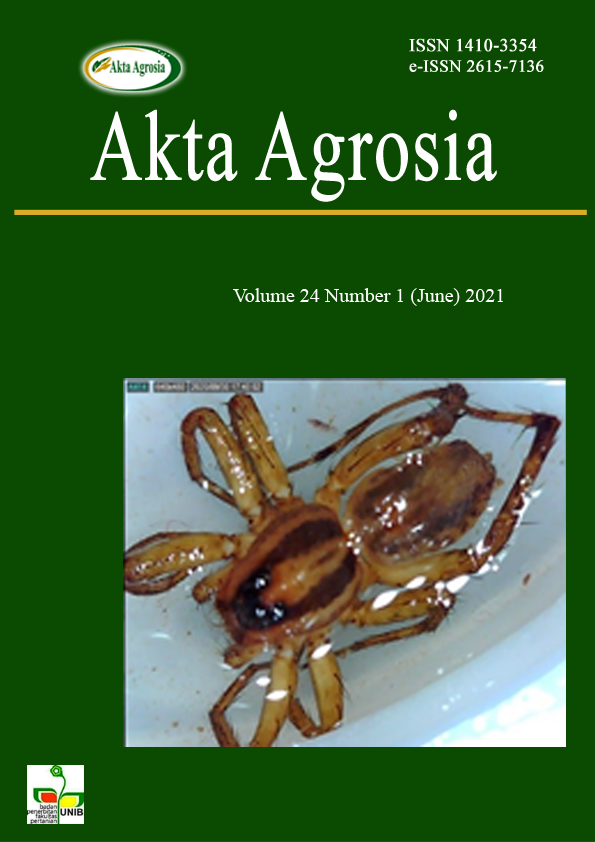Main Article Content
Abstract
Mulberry plant (Morus alba) is a plant that has social and economic importance. This plant development is often done to harvest the fruit and leaves. The social importance can be found in that this plant, especially in its leaves, is used in silkworm feed (Bombyx mori) and then silk is used in traditional clothes in Indonesia. Cultivation of mulberry plant (leaves and fruit) ideally by Integrated Pest Management (IPM) is necessary so that mulberry plants grow ideally and leaves have high quality and quantity without becoming a source of inoculum for pests and diseases of silkworm maintenance. Mulberry cultivation is generally carried out without using pesticide input so it is interesting in monitoring pests and natural enemies in the mulberry ecosystem. The research was conducted on two varieties of mulberry plants, namely Morus alba var. Kanva-2 and Morus cathayana in the same agroecosystem. Observation of pests and natural enemies was carried out using yellow sticky traps (YST) and pitfall traps (PFT). The orders and families found in the two varieties showed acroceridae family of 37.81% in the YST and hypogastruridae family with a value of 83.76% in the PFT observation.
Keywords: IPM, Morus alba, natural enemies, pest, trapping.
Article Details
Copyright (c) 2021 Adrian Triandi, Nadzirum Mubin, Lia Nurulalia

This work is licensed under a Creative Commons Attribution-ShareAlike 4.0 International License.
Authors who publish with this journal agree to the following terms:
- Authors retain copyright and grant the journal right of first publication with the work simultaneously licensed under a Creative Commons Attribution License that allows others to share the work with an acknowledgement of the work's authorship and initial publication in this journal.
- Authors are able to enter into separate, additional contractual arrangements for the non-exclusive distribution of the journal's published version of the work (e.g., post it to an institutional repository or publish it in a book), with an acknowledgement of its initial publication in this journal.
- Authors are permitted and encouraged to post their work online (e.g. in institutional repositories or on their website) prior to and during the submission process, as it can lead to productive exchanges, as well as earlier and greater citation of published work (See The Effect of Open Access).
References
- Bandyopadhyay UK., Santhakumar MV, Das NK, Mukherjee PK, Urs,SR.2004. Efficacy of yellow sticky traps in monitoring the mulberry whitefly, Dialeuropora decempuncta. Pest Management in Horticultural Ecosystem. 10(1): 49-54.
- Barahoei H, Rahksani E, Madjdzadeh SM, Alipour A, Taheri S, Nader E, Bogdanovic AM, Obradovic OP, et al.2013. Aphid parasitoid species (Hymenoptera: Braconidae: Aphidiinae) of central submountains of Iran. North-Western Journal Of Zoology.9(1):70-93.
- Borowski J, Mazur S. 2015. Beetles (Coleoptera) of the Rogów region. Part IV – clown beetles (Histeridae) and false clown beetles (Sphaeritidae). International Letters of Natural Sciences 37(1): 10–17.
- Eisenhauer N, Sabais ACW, Scheu S. 2011. Collembola species composition and diversity effects on ecosystem functioning vary with plant functional group identity. Soil Biology and Biochemistry. 43(8): 1697-1704.
- Ghosh A, Gangopadhyay D, Chowdhury T. 2017. Economical and environmental importance of mulberry: a review. International Journal of Plant and Environment.3(2):67-72.
References
Bandyopadhyay UK., Santhakumar MV, Das NK, Mukherjee PK, Urs,SR.2004. Efficacy of yellow sticky traps in monitoring the mulberry whitefly, Dialeuropora decempuncta. Pest Management in Horticultural Ecosystem. 10(1): 49-54.
Barahoei H, Rahksani E, Madjdzadeh SM, Alipour A, Taheri S, Nader E, Bogdanovic AM, Obradovic OP, et al.2013. Aphid parasitoid species (Hymenoptera: Braconidae: Aphidiinae) of central submountains of Iran. North-Western Journal Of Zoology.9(1):70-93.
Borowski J, Mazur S. 2015. Beetles (Coleoptera) of the Rogów region. Part IV – clown beetles (Histeridae) and false clown beetles (Sphaeritidae). International Letters of Natural Sciences 37(1): 10–17.
Eisenhauer N, Sabais ACW, Scheu S. 2011. Collembola species composition and diversity effects on ecosystem functioning vary with plant functional group identity. Soil Biology and Biochemistry. 43(8): 1697-1704.
Ghosh A, Gangopadhyay D, Chowdhury T. 2017. Economical and environmental importance of mulberry: a review. International Journal of Plant and Environment.3(2):67-72.
